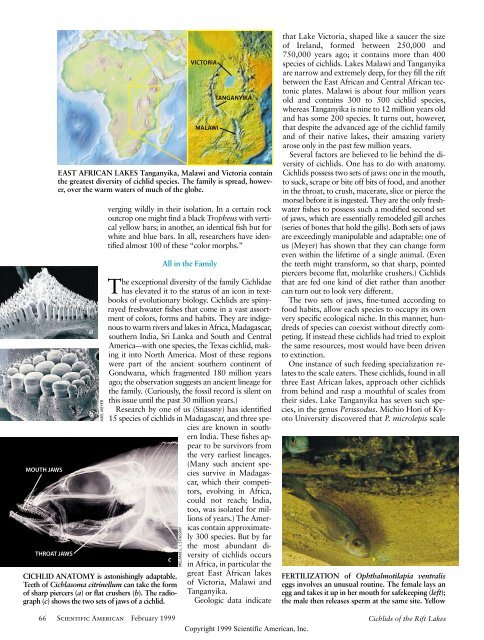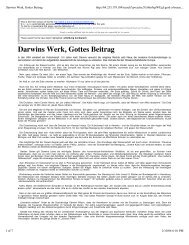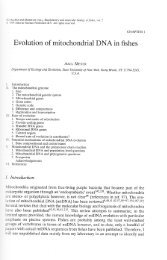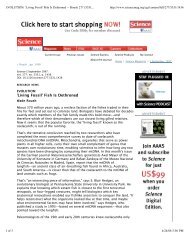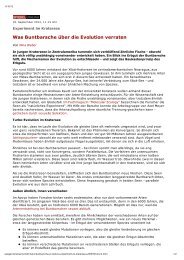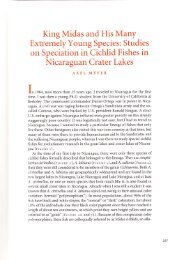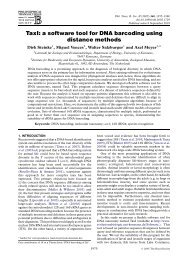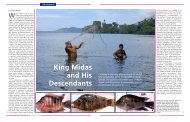Cichlids of the Rift Lakes - Scientific American Digital
Cichlids of the Rift Lakes - Scientific American Digital
Cichlids of the Rift Lakes - Scientific American Digital
You also want an ePaper? Increase the reach of your titles
YUMPU automatically turns print PDFs into web optimized ePapers that Google loves.
MOUTH JAWS<br />
THROAT JAWS<br />
EAST AFRICAN LAKES Tanganyika, Malawi and Victoria contain<br />
<strong>the</strong> greatest diversity <strong>of</strong> cichlid species. The family is spread, however,<br />
over <strong>the</strong> warm waters <strong>of</strong> much <strong>of</strong> <strong>the</strong> globe.<br />
a<br />
b<br />
AXEL MEYER<br />
CICHLID ANATOMY is astonishingly adaptable.<br />
Teeth <strong>of</strong> Cichlasoma citrinellum can take <strong>the</strong> form<br />
<strong>of</strong> sharp piercers (a) or flat crushers (b). The radiograph<br />
(c) shows <strong>the</strong> two sets <strong>of</strong> jaws <strong>of</strong> a cichlid.<br />
verging wildly in <strong>the</strong>ir isolation. In a certain rock<br />
outcrop one might find a black Tropheus with vertical<br />
yellow bars; in ano<strong>the</strong>r, an identical fish but for<br />
white and blue bars. In all, researchers have identified<br />
almost 100 <strong>of</strong> <strong>the</strong>se “color morphs.”<br />
All in <strong>the</strong> Family<br />
The exceptional diversity <strong>of</strong> <strong>the</strong> family Cichlidae<br />
has elevated it to <strong>the</strong> status <strong>of</strong> an icon in textbooks<br />
<strong>of</strong> evolutionary biology. <strong>Cichlids</strong> are spinyrayed<br />
freshwater fishes that come in a vast assortment<br />
<strong>of</strong> colors, forms and habits. They are indigenous<br />
to warm rivers and lakes in Africa, Madagascar,<br />
sou<strong>the</strong>rn India, Sri Lanka and South and Central<br />
America—with one species, <strong>the</strong> Texas cichlid, making<br />
it into North America. Most <strong>of</strong> <strong>the</strong>se regions<br />
were part <strong>of</strong> <strong>the</strong> ancient sou<strong>the</strong>rn continent <strong>of</strong><br />
Gondwana, which fragmented 180 million years<br />
ago; <strong>the</strong> observation suggests an ancient lineage for<br />
<strong>the</strong> family. (Curiously, <strong>the</strong> fossil record is silent on<br />
this issue until <strong>the</strong> past 30 million years.)<br />
Research by one <strong>of</strong> us (Stiassny) has identified<br />
15 species <strong>of</strong> cichlids in Madagascar, and three species<br />
are known in sou<strong>the</strong>rn<br />
India. These fishes appear<br />
to be survivors from<br />
<strong>the</strong> very earliest lineages.<br />
(Many such ancient species<br />
survive in Madagascar,<br />
which <strong>the</strong>ir competitors,<br />
evolving in Africa,<br />
could not reach; India,<br />
too, was isolated for millions<br />
<strong>of</strong> years.) The Americas<br />
contain approximately<br />
300 species. But by far<br />
<strong>the</strong> most abundant di-<br />
66 <strong>Scientific</strong> <strong>American</strong> February 1999<br />
c<br />
MELANIE L. J. STIASSNY<br />
VICTORIA<br />
MALAWI<br />
TANGANYIKA<br />
versity <strong>of</strong> cichlids occurs<br />
in Africa, in particular <strong>the</strong><br />
great East African lakes<br />
<strong>of</strong> Victoria, Malawi and<br />
Tanganyika.<br />
Geologic data indicate<br />
Copyright 1999 <strong>Scientific</strong> <strong>American</strong>, Inc.<br />
that Lake Victoria, shaped like a saucer <strong>the</strong> size<br />
<strong>of</strong> Ireland, formed between 250,000 and<br />
750,000 years ago; it contains more than 400<br />
species <strong>of</strong> cichlids. <strong>Lakes</strong> Malawi and Tanganyika<br />
are narrow and extremely deep, for <strong>the</strong>y fill <strong>the</strong> rift<br />
between <strong>the</strong> East African and Central African tectonic<br />
plates. Malawi is about four million years<br />
old and contains 300 to 500 cichlid species,<br />
whereas Tanganyika is nine to 12 million years old<br />
and has some 200 species. It turns out, however,<br />
that despite <strong>the</strong> advanced age <strong>of</strong> <strong>the</strong> cichlid family<br />
and <strong>of</strong> <strong>the</strong>ir native lakes, <strong>the</strong>ir amazing variety<br />
arose only in <strong>the</strong> past few million years.<br />
Several factors are believed to lie behind <strong>the</strong> diversity<br />
<strong>of</strong> cichlids. One has to do with anatomy.<br />
<strong>Cichlids</strong> possess two sets <strong>of</strong> jaws: one in <strong>the</strong> mouth,<br />
to suck, scrape or bite <strong>of</strong>f bits <strong>of</strong> food, and ano<strong>the</strong>r<br />
in <strong>the</strong> throat, to crush, macerate, slice or pierce <strong>the</strong><br />
morsel before it is ingested. They are <strong>the</strong> only freshwater<br />
fishes to possess such a modified second set<br />
<strong>of</strong> jaws, which are essentially remodeled gill arches<br />
(series <strong>of</strong> bones that hold <strong>the</strong> gills). Both sets <strong>of</strong> jaws<br />
are exceedingly manipulable and adaptable: one <strong>of</strong><br />
us (Meyer) has shown that <strong>the</strong>y can change form<br />
even within <strong>the</strong> lifetime <strong>of</strong> a single animal. (Even<br />
<strong>the</strong> teeth might transform, so that sharp, pointed<br />
piercers become flat, molarlike crushers.) <strong>Cichlids</strong><br />
that are fed one kind <strong>of</strong> diet ra<strong>the</strong>r than ano<strong>the</strong>r<br />
can turn out to look very different.<br />
The two sets <strong>of</strong> jaws, fine-tuned according to<br />
food habits, allow each species to occupy its own<br />
very specific ecological niche. In this manner, hundreds<br />
<strong>of</strong> species can coexist without directly competing.<br />
If instead <strong>the</strong>se cichlids had tried to exploit<br />
<strong>the</strong> same resources, most would have been driven<br />
to extinction.<br />
One instance <strong>of</strong> such feeding specialization relates<br />
to <strong>the</strong> scale eaters. These cichlids, found in all<br />
three East African lakes, approach o<strong>the</strong>r cichlids<br />
from behind and rasp a mouthful <strong>of</strong> scales from<br />
<strong>the</strong>ir sides. Lake Tanganyika has seven such species,<br />
in <strong>the</strong> genus Perissodus. Michio Hori <strong>of</strong> Kyoto<br />
University discovered that P. microlepis scale<br />
FERTILIZATION <strong>of</strong> Ophthalmotilapia ventralis<br />
eggs involves an unusual routine. The female lays an<br />
egg and takes it up in her mouth for safekeeping (left);<br />
<strong>the</strong> male <strong>the</strong>n releases sperm at <strong>the</strong> same site. Yellow<br />
<strong>Cichlids</strong> <strong>of</strong> <strong>the</strong> <strong>Rift</strong> <strong>Lakes</strong>


